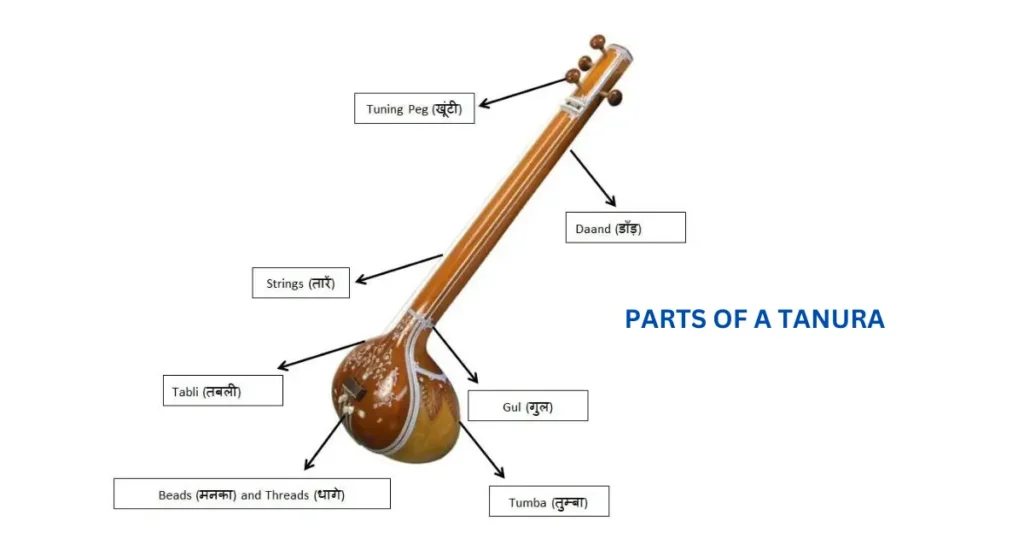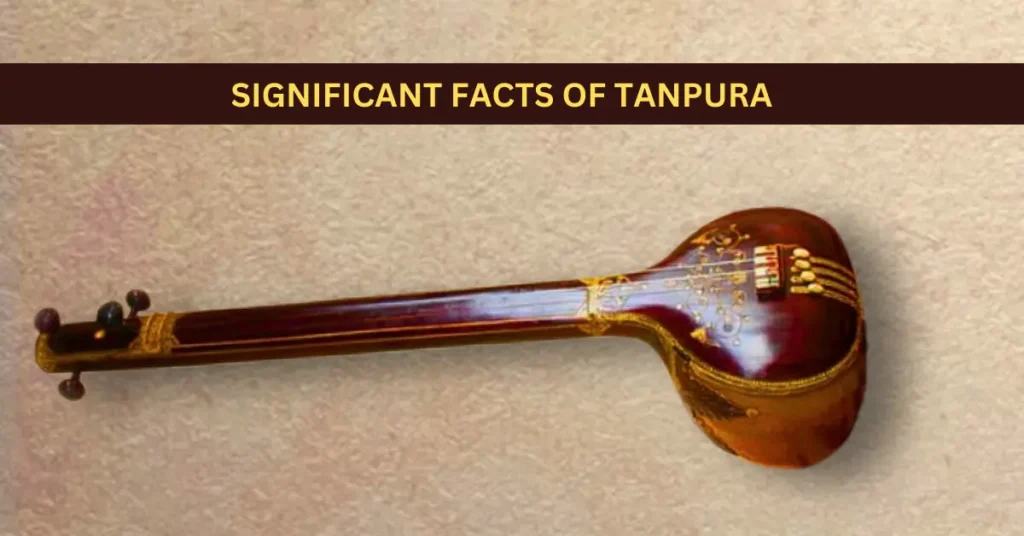What is Tanpura: An Introduction
Tanpura is an integral part of Indian Classical Music, be it Hindustani or Carnatic Music. It holds a unique position in the domain of Indian Classical music.
Similar to vocals, the tanpura is also played in classical instrumental musical performances, accompanying instruments like sitar, bansuri, violin, sarod, and shahnai.
Being a drone instrument it serves as a backbone of classical music performances producing the adharaswara (base note) or the key notes to a musician so that he can sing or perform his instrument without going out of tune.
Below is an excellent video on tanpura tuning and playing demonstrated by Anol Chatterjee one of the finesh Vocalist, Trainer, Composer, Lyricist.
Table of Contents
The tanpura also provides a meditative ambience and a stable foundation for musicians to explore the depths of their art.
Use of Tanpura in Music
In Indian classical music, the tamboura is a drone instrument that usually plays two notes continuously: the base note, Shadja, and Pancham. To sing or play some ragas where Madhyam note is prominent, it is tuned to Madhyam note instead of Pancham.
It is traditionally played by hand (index and middle finger) to pluck the strings
As said in the introduction section above, tanpura conveys the base note or scale utilized in a performance, supporting singers and instrumentalists.
In order to be compatible with other instruments, the base note is typically adjusted to a normal western pitch with A440Hz as the pitch reference.
This article introduces seven significat facts about the extraordinary instrument at hand. Let’s take a detailed look at each of these facts one by one.
1. Design and Structure
The tanpura is a plucked musical instrument with a hollow body, carefully crafted to produce a rich and resonant sound. The components include the Khuti (Tuning pegs), Daand (the long neck), Taren (Strings), Tabli ( soundboard) Tumba (gourd) , and neck Gulu (heel) .

The instrument is meticulously designed to emit all seven notes of the musical gamut, creating a continuous drone known as adhar swara.
2. Materials and Types
Out of the two types of wood used to make tanpuras, tun (red cedar) is better and more liked than teak. This is because, even though they’re quite similar in quality, tun is a bit lighter and not as dense as teak, which makes it produce better sound vibrations.
Traditionally made of teak or Spanish Cedar (tun wood), the tanpura is available in two varieties: male and female, both having different dimensions.
The overall length of a male tanpura is fifty-seven inches, while the female tanpura is somewhat shorter at fifty-one inches.
To get the correct resonance, careful wood selection is essential. Rosewood is a good choice for the pegs, and stag horn is used for the bridge and bolts.
3. Origin and History
History suggests that the tanpura originated with an instrument that originated in the Balkan region.
Furthermore, Indian traditional instruments such as the tamburi, tuntuni, and gopi-yantra are compared to the earliest tamburas. The tumba gourd is the source of the tambura’s name. Thus, it’s this unique fusion of elements from other cultures that has contributed to the current state of Indian music’s tanpura.
4. Evolution and Innovation Of Tanpura
Within Indian traditional music, the tanpura has undergone modifications to accommodate modern demands as tradition and innovation mix.
A more portable and easily handled version of the classic tanpura, the Tamburi, has emerged to address these concerns while preserving sound quality. This creative idea offers a comfortable travel option for artists who are constantly on the run.
5. Playing Technique and Function
The tanpura plays a unique role by generating a melodic backdrop without producing a melody of its own. Artists are free to explore a variety of musical components due to the constant drone it generates. Its four tuned strings are plucking rhythmically to provide a constant harmonic drone that supports and feeds the performances of singers and instrumentalists.
6. Cultural Significance
Given that the tanpura is a part of both Hindustani and Carnatic music traditions, its cultural significance is evident. In the south, it is called tambura, but in the north, it is called tanpura.
It is an essential component of classical compositions and performances because of its ability to improve the melodic continuity for struck and plucked instruments.
7. Electronic and Application Tanpura
Electronic tanpuras and tanpura applications represent innovative solutions that blend technology with the rich tradition of Indian classical music. Electronic Tanpuras can be further classified into Electronic Tanpura and Application Tanpura.
Electronic Tanpuras
Electronic instruments created to mimic the sound of a conventional tanpura are known as electronic tanpuras.
They frequently have movable settings that let artists alter the volume, tone, and pitch. Because of its famed portability, electronic tanpuras are useful for both rehearsal and live performances. They offer a dependable substitute for the conventional, larger tanpuras, particularly when weight and space are important factors.
Tanpura Applications
Musicians are increasingly using tanpura software in the age of smartphones and tablets.
These apps offer a variety of functions, such as various tunings, scales, and tempos, and mimic the sound of a tanpura. These apps are easily carried by musicians on their gadgets, which facilitates practicing or playing with a virtual tanpura wherever they are. Tanpura apps serve a broad range of users, including seasoned performers searching for a portable solution and novices looking for a practice partner.
Conclusion:
The tanpura symbolizes the enduring traditions and innovations in Indian classical music. Its melodic background, harmonic drone, and sustained resonance enhance the immersive nature of classical performances.
As artists explore new realms of musical expression, the tanpura stands as a steadfast companion, enriching the sonic tapestry of Indian classical music.
What is tanpura called in English?
The term “tanpura” is used in English because it’s a loanword from Sanskrit, preserving cultural and historical continuity in the context of Indian classical music.
What is tambura made of?
The tambura is typically made of wood, and materials such as teak or cedar are commonly used in its construction.
What is the Tumba of tanpura made of?
The “tumba” of a tanpura, also known as the resonator or gourd, is traditionally made from a hollowed and dried pumpkin or gourd. This component contributes to the sound resonance of the tanpura.
What is the difference between tambura and tanpura?
“Tambura” and “tanpura” refer to the same instrument, with regional variations in naming. “Tambura” is common in the south, while “tanpura” is used in the north of India. Both describe the plucked string drone instrument in Indian classical music.
What are the 4 strings of tanpura?
The four strings of a tanpura are traditionally tuned to the notes Sa, Pa, Sa, and Ma. These strings contribute to the continuous drone and harmonic support in Indian classical music performances.
Is tanpura and Veena same?
No, the tanpura and veena are different instruments. Tanpura provides a continuous drone in Indian classical music, while the veena is a larger, melodic string instrument often played solo.



